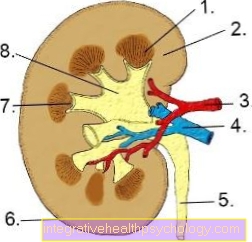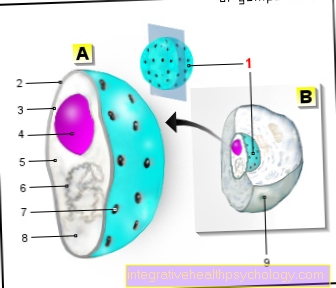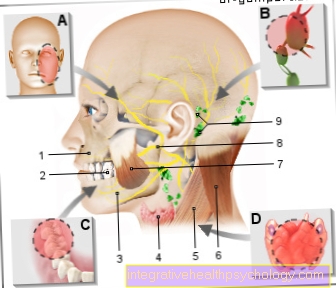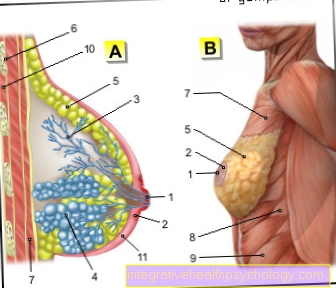Aortic dissection type A
definition
Aortic dissection is a bleeding into the wall of the main artery (aorta) of the body. The vessel wall splits into its various layers and blood flows between these individual layers. A new channel is created next to the aorta, through which blood can also flow.
The aortic dissection type Stanford A refers exclusively to such a splitting in the area of the so-called Ascending aorta. This is the part of the main artery that is located directly on the heart. In type B, however, the rest of the aorta is affected.
For more information, see: Aortic dissection

diagnosis
Type A aortic dissection is often an emergency. Therefore, the most reliable and fastest diagnostic method must be selected in the event of symptoms that suggest the suspicion of aortic dissection. A CT with contrast agent is usually performed for this purpose, as it is a very fast and precise imaging method. The exact location of the dissection can also be shown. Further procedures are the ultrasound of the chest, an MRI (duration approx. 30 minutes) or a conventional X-ray.
Symptoms
So-called annihilation pain is typical of aortic dissection. This is the strongest pain that starts suddenly. In type A aortic dissection, the pain center is in the chest; the pain can also occur between the shoulder blades and radiate into the back across the entire thoracic spine. The pain can also be transmitted to the abdomen. However, this tends to suggest an aortic dissection in the section of the aorta that is actually in the abdomen. Affected people often describe the pain as burning or tearing.
The aortic dissection changes the blood flow. Some organs are no longer supplied with sufficient blood. Since type A is a dissection in the initial part of the aorta, all organs can be affected. In the brain, for example, a lack of blood quickly triggers a faint. When the coronary arteries emerging from the Ascending aorta come off, are affected, it comes to a heart attack with sudden pain and pressure on the chest. In addition, shortness of breath can occur. Aortic dissection can be associated with severe and sudden blood loss, causing shock that may require resuscitation.
also read: Symptoms of aortic dissection
What is the life expectancy with a type A aortic dissection?
Type A aortic dissection is usually a difficult emergency situation. If the dissection is accompanied by high blood loss, the chances of survival are very poor. Within a few minutes, the heart pumps the entire volume of blood in the body through the aorta. As a result, a large number of those affected do not get to a clinic on time.
If quick action was taken in this emergency situation, emergency surgery and the addition of blood supplies can be life-saving. Still, survival within the next 30 days is critical. About 80% of the operated persons survive this period. Type A aortic dissection often ends fatally even without severe acute blood loss. Of those who choose not to have surgery, only half survive the next 30 days. Despite the operation, about 20% of the treated people die.
Those who have survived the critical interval of 30 days have a very good life expectancy. In the following period it will play a decisive role whether risk factors can be contained. Existing high blood pressure must be treated as well as hypercholesterolemia (increase in blood lipid levels), which leads to calcification of the vessels. A healthy diet and regular physical activity also have a positive effect on the cardiovascular system and can thus improve life expectancy.
OP
The operation is an absolute must for type A aortic dissection, as the mortality rate with conservative therapy is 50%. It is also an absolute emergency indication, since the mortality rate increases by 1% with every hour that has passed. The operation is performed under general anesthesia. An aortic stent can be used to bridge the area of the dissection. This is pushed over a large blood vessel on the thigh to the front part of the aorta, where it lines the aorta.
Another procedure is to implant a plastic prosthesis in place of the ascending aorta. The chest must be opened for this. The affected person is connected to the heart-lung machine, which takes over the pumping function of the heart for a certain time. The heart is then immobilized with medication, since a prosthesis cannot be implanted on the beating heart. Since type A aortic dissection is the more dangerous of the two types of dissection, implantation of the plastic prosthesis on the open chest is preferred. An aortic stent is only used if the surgical risk is too high, for example due to previous lung diseases.
You might also be interested in: Aortic prosthesis
Aftercare
Since type A aortic dissection is a dangerous disease, consistent follow-up care is absolutely necessary. After the operation, this initially consists of monitoring in the intensive care unit and later in a normal ward. This is followed by a rehabilitation program that treats physical and psychological aspects of the disease. In the long term, proper blood pressure control is essential. In addition, CT examinations are carried out regularly. As a result, a renewed widening in the area of the ascending aorta can be detected and treated at an early stage.
forecast
When it comes to the survival prognosis, one speaks of different critical times. The so-called "first hit" is the time immediately after the dissection, before the person reaches the hospital. The type A dissection is often accompanied by a large amount of blood loss, where volume and emergency surgery must be performed within minutes.
The "second hit" is the operation itself. About 80% of the operated people survive. The “third hit” summarizes possible complications that may arise within the next month and is largely dependent on how severely other organ systems were damaged by the blood loss. The brain and kidneys are particularly sensitive.
causes
The causes of type A aortic dissection are diverse. High blood pressure (arterial hypertension) and arteriosclerosis (calcification of the blood vessels) are particular risk factors. The increased blood pressure creates more forces on the vessel wall. In addition, the structure of the wall can be weakened by the calcifications. In combination, the two diseases can cause the aortic wall to split apart.
Connective tissue diseases can also be a reason for an aortic dissection. Due to the disease, the vascular wall is structured differently than in healthy people. As a result, it is often unable to counteract the forces that exist in the aorta for life. The most well-known connective tissue diseases that are particularly often associated with aortic dissection are Marfan and Ehlers-Danlos syndromes.
Other vascular-changing diseases come from the autoimmune circle. These are diseases in which the body attacks itself. This can lead to inflammation and thus weakening of the vessel walls.
Causes such as trauma to the thorax are specific to type A aortic dissection. This often occurs in car accidents, where the seat belt or steering wheel exerts great force on the chest. An operation on the aorta, such as a bypass operation, can also weaken the vessel wall and thus cause a dissection in the area of the ascending aorta.





























